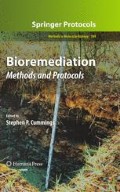Abstract
Bioremediation has been identified as a beneficial and effective strategy for the removal of recalcitrant environmental contaminants. Bioaugmentation of polluted environments with exogenous degrading microorganisms constitutes a major strategy of bioremediation. However, the ecological role of these strains and their impact on the endogenous microbial community of the micro-ecosystems where they are released should be known. Fingerprinting PCR-based methods, like denaturating gradient gel electrophoresis (DGGE) and terminal restriction fragment length polymorphism (TRFLP), could be used in studies exploring the ecology of pollutant-degrading microorganisms and their effects on the structure of the soil microbial community. This chapter provides a brief outline of the technical details involved in the application of DGGE and TRFLP fingerprinting in soil microbial ecology, with particular reference to bioremediation studies.
Access this chapter
Tax calculation will be finalised at checkout
Purchases are for personal use only
References
Miyasaka, T., Asami, H., and Watanabe, K. (2006) Impacts of bioremediation schemes on bacterial population in naphthalene-contaminated marine sediments. Biodegradation 17, 227–235.
Kirk, J.L., Beaudette, L.A., Hart, M., Moutoglis, P., Klironomos, J.N., Lee H., et al. (2004). Methods of studying soil microbial diversity. J. Microbiol. Meth. 58, 169–188.
Lynch, J.M., Benedetti, A., Insam, H., Nutti, M.P., Smalla, K., Torsvik, V., et al (2004) Microbial diversity in soil: ecological theories, the contribution of molecular techniques and the impact of transgenic plants and transgenic microorganisms. Biol. Fertil. Soils 40, 363–385.
Singh, B.K., Walker, A., Morgan, J.A.W., and Wright, D.J. (2003). Effects of soil PH on the biodegradation of chlorpyrifos and isolation of a chorpyrifos-degrading bacterium. Appl. Environ. Microbiol. 69, 5198–5206.
Singh, B.K., Walker, A., Morgan, J.A.W., and Wright, D.J. (2003). Role of soil pH in the development of enhanced biodegradation of fenamiphos. Appl. Environ. Microbiol. 69, 7035–7043.
Bending, G.D., Lincoln, S.D., Sorensen, S.R., Morgan, J.A.W., Aamand, J., and Walker, A. (2003). In-field spatial variability in the degradation of the phenyl-urea herbicide isoproturon is the result of interactions between degradative Sphingomonas spp. and soil PH. Appl. Environ. Microbiol. 69, 827–834.
Dejonghe, W., Berteloot, E., Goris, J., Boon, N., Crul, K., Maertens, S., et al., (2003) Synergistic degradation of linuron by a bacterial consortium and isolation of a single linuron-degrading Variovax strain. Appl. Environ. Microbiol. 69, 1532–1541.
Shi, S., and Bending, G.D. (2007) Changes to the structure of Sphingomonas spp. communities associated with biodegradation of the herbicide isoproturon in soil. FEMS Microbiol. Lett. 269, 110–116.
Breugelmans, P., D’Huys, P-T., Mot, R.D., and Springael, D. (2007) Characterization of novel linuron-mineralizing bacteria consortia enriched from long-term linuron-treated agricultural soils. FEMS Microbiol. Ecol. 62, 374–385.
Cunliffe, M., and Kertesz M.A. (2006) Effect of Sphingobium yanoikuyae B1 on bacterial community dynamics and polycyclic aromatic hydrocarbon degradation in aged and freshly PAH-contaminated soils. Environ. Pollut. 114, 228–237.
MacNaughton, S.J., Stephen, J.R., Venosa, A.D., Davis, G.A., Chang Y.-J., and White D.C. (1999) Microbial population changes during bioremediation of an experimental oil spill. Appl. Environ. Microbiol. 65, 3566–3574.
Raina, V., Suar, M., Singh, A., Prakash, O., Dadhwal, M., Gupta, S.K., et al. (2007) Enhanced biodegradation of hexachlorocyclohexane (HCH) in contaminated soils via inoculation with Sphingobium indicum B90A. Biodegradation 19, 27–40.
Kowalchuk, G.A., Stephen, J.R., DeBoer, W., Prosser, J.L., Embley, T.M., and Woldendorp. J.W. (1997). Analysis of β-Proteobacteria ammonia-oxidizing bacteria in coastal sand dunes using denaturating gradient gel electrophoresis and sequencing of PCR amplified 16 rDNA fragments. Appl. Environ. Microbiol. 63, 1489–1497
Heuer, H., Krsek, M., Baker, P., Smalla, K., and Wellington, E.M. (1997) Analysis of actinomycete communities by specific amplification of genes encoding 16S rRNA and gel-electrophoretic separation in denaturating gradients. Appl. Environ. Microbiol. 63, 3233–3241.
Leys, N.M.E.J., Ryngaert, A., Bastiaens, L., Verstraete, W., Top, E.M., and Springael D. (2004) Occurrence and phylogenetic diversity of Sphingomonas strains in soils contaminated with polycyclic aromatic hydrocarbons. App. Environ. Microbiol. 7, 1944 –1955.
Gardes, M., and Bruns T.D. (1993). ITS primers with enhanced specificity for basidiomycetes – application to the identification of mycorrhizae and rusts. Molec. Ecol. 2, 113–118.
Larena, I., Salazar, O., Gonzalez, V., Julian, M.C., and Rubio, V. (1999) Design of a primer for ribosomal DNA internal transcribed spacer with enhanced specificity for ascomycetes. J. Biotech. 75, 187–194.
Helgason, T., Daniell, T.J., Husband, R., Fitter, A.H., and Young J.P.W. (1998) Ploughing up the wood-wide web? Nature 394, 431.
Liang, Z., Drijber, R.A., Lee, D.J., Dwiekat, I.M., Harris, S.D., and Wedin, D.A. (2008) A DGGE-cloning method to characterize arbuscular mycorrhizal community structure in soil. Soil Biol. Biochem. 40, 495–504.
Marzorati, M., Wittebolle, L., Boon, N., Daffonchio D., and Verstraete, W. (2008) How to get more out of molecular fingerprints: practical tools for microbial ecology. Environ. Microbiol. (10, 1571–1581 doi:10.1111/j.1462-2920.2008.01572.x).
Singh, B.K., Nazaries, L., Munro, S., Anderson, I.C., and Cambell, C.D. (2006) Use of multiplex terminal restriction fragment length polymorphism for rapid and simultaneous analysis of different components of the soil microbial community. Appl. Environ. Microbiol. 76, 7278–7285
Singh, B.K., and Thomas, N. (2006) Multiplex terminal restriction fragment length polymorphism. Nature Prot. 1, 2428–2433.
Author information
Authors and Affiliations
Editor information
Editors and Affiliations
Rights and permissions
Copyright information
© 2010 Humana Press
About this protocol
Cite this protocol
Karpouzas, D.G., Singh, B.K. (2010). Application of Fingerprinting Molecular Methods in Bioremediation Studies. In: Cummings, S. (eds) Bioremediation. Methods in Molecular Biology, vol 599. Humana Press. https://doi.org/10.1007/978-1-60761-439-5_5
Download citation
DOI: https://doi.org/10.1007/978-1-60761-439-5_5
Published:
Publisher Name: Humana Press
Print ISBN: 978-1-60761-440-1
Online ISBN: 978-1-60761-439-5
eBook Packages: Springer Protocols

